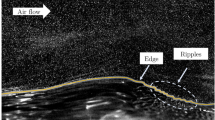Abstract
In August 2014, measurements of the turbulent velocity rotor, turbulent temperature gradient, turbulent helicity, and turbulent potential vortex were performed at the Obukhov Institute of Atmospheric Physics testing ground in Tsimlyansk under different stratification conditions. The measurements were carried out using the technique first used in the Tsimlyansk expedition in 2012 [1]. The measuring facility consisted of four three-component acoustic Gill Windmaster anemometers–thermometers placed at the vertices of a rectangular tetrahedron with a base scale of 0.7 m (in contrast to the experiment in 2012, when the base scale was 5 m). The measuring facility was placed on top of a mast with an adjustable height of 3.5, 5, 13.5, and 25 m and was equipped with a rotator. The temperature profile in the 10–600 m layer was continuously recorded by the Kadygrov microwave profiler [2]. The series of density of instantaneous helicity He = ui'ω'i = u1'ω1' + u2'ω'2 + u3'ω'3 and average values of the total and its summands were calculated for 12 daytime and 10 daytime 2-hour intervals. The helicity value averaged over 12 day realizations is about 0.2 m/s2, and the average cosine is close to 0.08 ± 0.03. At night, the helicity is estimated as 0.07 ± 0.03 m/s2, and the cosine is close to 0.025 ± 0.03. For the abovementioned 12 daytime and 10 daytime 2-hour intervals, the covariance and correlation matrices of temperature components, velocity rotor, velocity, and temperature gradient are calculated. The off-diagonal terms of the covariance matrix exceed by absolute values the diagonal terms several times. Similar characteristics of a potential vortex were estimated in the incompressibility approximation. The systematic error due to spatial averaging of the measured quantities is discussed.
Similar content being viewed by others
References
B. M. Koprov, V. M. Koprov, M. V. Kurgansky, and O. G. Chkhetiani, “Helicity and potential vorticity in surface turbulence,” Izv., Atmos. Ocean. Phys. 51 (6), 565–575 (2015).
E. N. Kadygrov and I. N. Kuznetsova, Methodical Recommendations on the Use of Data on Temperature Profiles in the Atmospheric Boundary Layer Measured Remotely by Microwave Profilometers: Theory and Practice (Fizmatlitkniga, Dolgoprudnyi, 2015) [in Russia].
A. A. Fridman, “O raspredelenii temperatury s vysotoi pri nalichnosti luchistogo teploobmena Zemli i Solntsa,” Izv. Gl. Astron. Obs., No. 2, 42 (1920).
A. S. Monin and A. M. Obukhov, “Main regularities of turbulent mixing in the atmospheric surface layer,” Tr. Inst. Geofiz. Akad. Nauk SSSR 24, 163–187 (1954).
B. M. Koprov, V. M. Koprov, and T. I. Makarova, “Convective structures in the atmospheric surface layer,” Izv., Atmos. Ocean. Phys. 36 (1), 37–47 (2000).
R. A. Antonia, A. J. Chambers, C. A. Friehe, and C. W. Van-Atta, “Temperature ramps in the atmospheric surface layer,” J. Atmos. Sci. 36 (1), 99–108.
L. D. Landau and E. M. Lifshits, Hydrodynamics (Nauka, Moscow, 1986) [in Russian].
F. V. Dolzhansky, Basics of Geophysical Hydrodynamics (Fizmatlit, Moscow, 2011) [in Russian].
L. G. Elagina, B. M. Koprov, and D. F. Timanovskii, “Some characteristics of the atmospheric surface layer over snow,” Izv. Akad. Nauk, Fiz. Atmos. Okeana 14 (9), 926–931 (1978).
G. Batchelor, An Introduction to Fluid Dynamics (Cambridge University Press, Cambridge, 1967; Mir, Moscow, 1973)
E. A. Novikov, “Vortex flow,” Izv. Akad. Nauk SSSR, Fiz. Atmos. Okeana 8 (7), 459–462 (1972).
B. M. Koprov, V. V. Kalugin, and N. S. Thieme, “Turbulent flow of a vortex,” Izv. Akad. Nauk, Fiz. Atmos. Okeana 30 (1), 13–17 (1994).
V. M. Bovsheverov, A. S. Gurvich, A. M. Kochetkov, and S. O. Lomadze, “Measurement of the frequency spectrum of small-scale circulation of velocity,” Izv. Akad. Nauk, Fiz. Atmos. Okeana 7 (4), 371–376 (1971).
B. M. Koprov, V. M. Koprov, V. M. Ponomarev, and O. G. Chkhetiani, “Experimental studies of turbulent helicity and its spectrum in the atmospheric boundary layer,” Dokl. Phys. 50 (8), 419–422 (2005).
J. C. Kaimal, J. C. Wyngaard, and Y. Izumi, “Spectral characteristics of surface-layer turbulence,” Q. J. R. Meteorol. Sci. 98, 563–589 (1972).
B. M. Boubnov and G. S. Golitsyn, Convection in Rotating Fluids (Kluwer, Dordrecht, 1995).
A. V. Belyan, S. S. Moiseev, and O. G. Chkhetiani, “On turbulent viscosity in helical turbulence,” Dokl. Akad. Nauk 334 (1), 34–36 (1994).
Author information
Authors and Affiliations
Corresponding author
Additional information
Original Russian Text © B.M. Koprov, V.M. Koprov, O.A. Solenaya, O.G. Chkhetiani, E.A. Shishov, 2018, published in Izvestiya Rossiiskoi Akademii Nauk, Fizika Atmosfery i Okeana, 2018, Vol. 54, No. 5, pp. 525–537.
Rights and permissions
About this article
Cite this article
Koprov, B.M., Koprov, V.M., Solenaya, O.A. et al. Technique and Results of Measurements of Turbulent Helicity in a Stratified Surface Layer. Izv. Atmos. Ocean. Phys. 54, 446–455 (2018). https://doi.org/10.1134/S0001433818050067
Received:
Accepted:
Published:
Issue Date:
DOI: https://doi.org/10.1134/S0001433818050067




